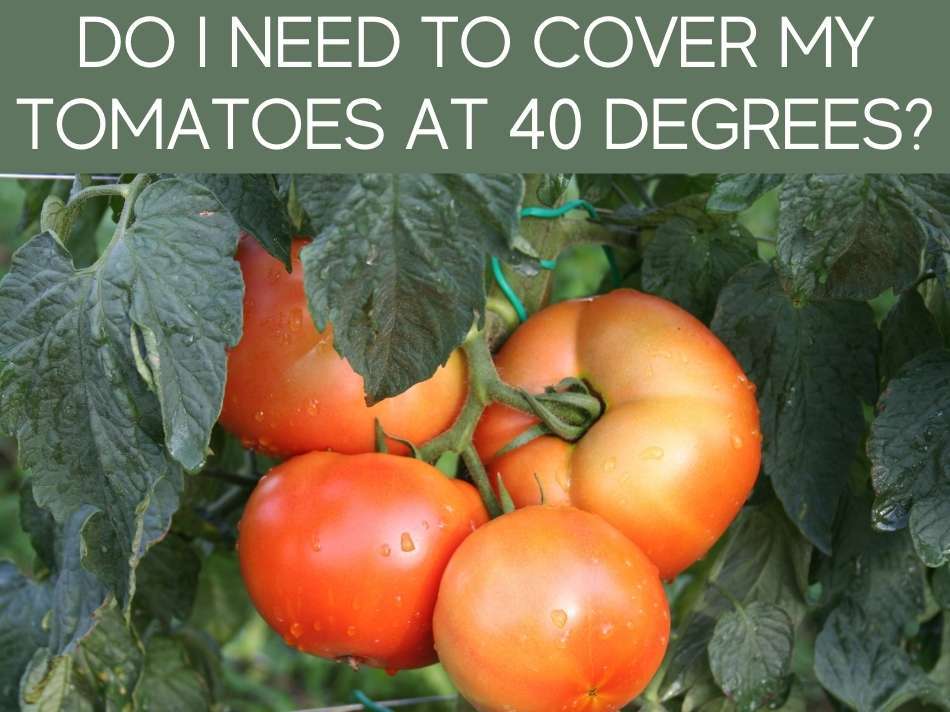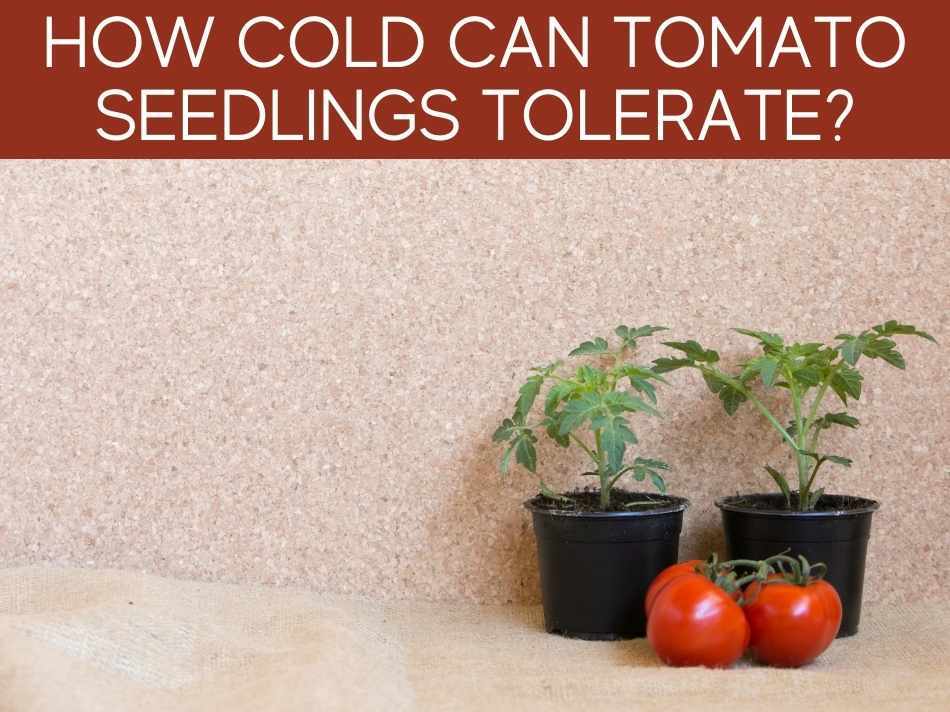It’s hard to find a vegetable garden without tomato plants. Tomatoes like full sun, fertile soil, & warm temperatures to grow healthy and produce bundles of tomatoes to harvest. So what’s the ideal climate for growing tomatoes? Is 40 degrees at night too cold for tomatoes?
Yes, 40°F at night is cold for tomatoes, and may damage the crop. Tomatoes grow best when daytime temperatures are between 70°F and 85°F, and nighttime temperatures are between 59°F and 68°F. Low nighttime temperatures (below 55 degrees) can inhibit pollen formation and fruit development.
The ideal temperature ranges for daytime & nighttime temperature can help gardeners predict the correct time to plant the seeds and set out transplants in their region.
How should you protect your tomato plants from the cold?
Will 40°F kill the tomato plants?
What damages can you expect?
Since you’re growing tomatoes, check out our full scoop on how to grow more tomatoes.
Is 40 Degrees Too Cold For Tomatoes?

40°F is too cold for your tomato plants to give you a viable harvest.
Generally, experts recommend providing cold protection to the tomato crop if temperatures below 50°F are predicted in the coming days.
Though 40°F is still not too cold to kill off the plants entirely, it will severely affect their productivity.
When strictly speaking of survival, your tomato plants can survive temperatures as low as 33°F.
But what good is a tomato plant that doesn’t even give you a few ripe, juicy tomatoes to munch on?
This is exactly why you need to protect your crops before the temperatures dip and ruin your harvest.
However, sometimes your tomato crops may fall prey to unexpected weather changes.
Can Tomato Plants Survive 40 Degree Weather?

Tomatoes are warm-season crops. Similar to most other warm-season vegetables, they don’t tolerate frost or cold temperatures.
They’re transplanted into the garden once all dangers of frost have passed and nighttime temperatures are consistently above 55°F.
Though tomato plants can survive 40°F weather, they’ll show problems.
The tomato plant’s temperature tolerance is of prime importance for flower development and fruit set.
Any unforeseen temperature changes during this period can practically sabotage a potentially perfect harvest.
What Problems Occur at 40 Degree Weather?

Though a 40°F temperature won’t kill your tomato plants, you cannot expect a perfect harvest.
There are several potential problems you can expect at temperatures this low:
- Nighttime temperatures lower than 55°F interfere with pollen formation and fruit ripening.
- If the daytime temperatures are high but nighttime temperatures are below 55°F in spring, blossom drop may occur.
- Cool nighttime temperatures can also inhibit the process of photosynthesis during the day. When the plants make less food, their growth will suffer.
- Transplants exposed to cold temperatures (below 65°F during the day and below 60°F at night) are more susceptible to catfacing. Catfacing is a condition that results in cracks, scars, or holes at the blossom end of the fruit.
- When temperatures dip below 50°F, tomatoes on the vine tend to drop off. You’ll need to give your plants additional care to protect the developing fruit from falling off the vines.
Can Tomatoes Survive 40 Degrees?

A 40°F (or 4.444°C) temperature isn’t fatal to tomato plants.
So, yes, your tomato plants will survive at 40°F temperature.
In fact, tomato plants can survive temperatures down to 33 degrees Fahrenheit (or 0.5556°C).
However, that doesn’t mean the plants will bloom and fruit optimally.
At temperatures as low as 40°F, or 0 to 5°C if you measure on the Celsius scale, tomato plants are prone to cold damage.
Some cold injury symptoms are:
- stunted growth,
- poor root development,
- wilting,
- leaf necrosis, and
- surface pitting.
At cold temperatures, tomato plants also show less immunity to diseases, and several other problems may result.
To prevent tomatoes from cold damage, start seeds indoors in a warm environment and set the transplants into the garden only once the soil has warmed in spring.
A seedling heat mat is ideal for starting seeds in colder temperatures.
Wait until the last frost of the spring has passed, and the temperatures are consistently above 55°F (or 13°C) at night. In case late frosts are expected, cover the plants to protect against cold injury.
Do I Need To Cover My Tomatoes At 40 Degrees?

As already highlighted in the post, tomatoes don’t like cold temperatures.
Tomatoes thrive when they receive consistently warm temperatures, between 70°F to 85°F during the day and between 59°F to 68°F during the night.
Now, since 40°F is way off the mark even for nighttime temperatures, covering the plants is an excellent idea to protect them from cold damage.
Different covers vary in their insulation characteristics, but they can all generally add a further 3 to 5 degrees to the surrounding air temperature, keeping the plants warmer.
Floating row covers can effectively protect tomato crops from temperatures between 26°F to 32°F.
While they offer good protection against cold temperatures for short periods, they won’t be of much use during extended freezes.
Tips To Cover Tomato Plants

- Different cover options are available. Frost blankets, cloth row covers, plastic, or tarp are all great choices.
- Remember to anchor them to the ground to prevent them from blowing away with the wind.
- You’ll only need to cover the plants at night. Remove the cover during the day to prevent your tomatoes from overheating.
- Make sure the plants don’t come in contact with the cover.
How Cold Can Tomato Seedlings Tolerate?

Tomato seeds germinate best when temperatures are between 75°F and 90°F. The minimum temperature for tomato seeds to sprout is 50°F.
Gardeners typically start tomato seeds indoors to ensure even temperatures and moisture.
Once the seedlings are more robust and the outdoor temperatures are suitable, they’re transplanted in the garden.
Seedlings grow best when temperatures are maintained between 65°F and 85°F.
Tomatoes aren’t cold-tolerant crops, and the seedlings are even more susceptible to frost damage than the mature plants.
This is exactly why most gardeners choose to grow seedlings indoors under controlled conditions rather than planting the seeds directly in the garden.
To grow tomatoes indoors, you’ll want to see our full article on how to grow tomatoes in a greenhouse.
So you know the ideal temperature to grow seedlings.
But how cold can the seedlings actually tolerate?
The answer really depends on the cultivar you’re growing, but generally, they shouldn’t go below 45°F (7°C).
Temperatures below 35°F(2°C) can kill the seedlings.
One way to keep seedlings a tad warmer is with a seedling heat mat: check out the full article on seedling heat mats & how to use them.
Oh, and aside from the cold, you might want to check out how much sun tomato seedlings need.
What Temp Is Too Cold For Tomatoes?

Different tomato cultivars have slightly different temperature tolerance.
Choose cultivars according to the climate you live in.
However, generally speaking, tomato crops will need frost protection if temperatures dip below 50°F.
If the temperatures further drop to below 33°F and there’s no protection against the cold, it may even kill your plants.
Cold Hardy Tomato Cultivars

If you live in a cooler climate where the growing season is shorter, there are some specific tomato cultivars that are bred to thrive in such conditions.
These cultivars aren’t just capable of setting fruit in cooler temperatures (below 55°F), but also mature quicker than the usual varieties (within 70 days).
Here are some top picks:
- Husky Gold
- Celebrity
- Orange Pixie
- Anna Russian
- Azoychka
- Beaverlodge Slicer
- Glacier
- Gold Nugget
- Legend
- Manitoba
- Bush Beefsteak
Will Cold Weather Hurt Tomato Plants?

Since tomatoes are warm-season vegetables, cold weather can easily hurt your plants, causing stunted growth, frost damage, & even killing tomato plants. The most severe damage to tomatoes will occur at temperatures below 33-34F.
It’s essential to keep them warm if you want to see optimal plant growth and the development of healthy fruits.
You have already seen how temperatures below the optimal range can cause damage to tomato plants.
Make sure the soil temperatures are warm enough when you set the transplants out in the garden, and take suitable measures if low temperatures are predicted in the coming days.
What Are The Solutions
It’s not impossible to grow tomatoes in northern climates. With the right care, you can pull off a perfect harvest in cooler regions too.
Here are some practical tips to protect your tomato plants from cold weather.
- Cover the tomato plants if cold temperatures are forecasted.
- If they’re growing in containers, move the plants indoors to protect them from the cold.
- Grow tomatoes in greenhouses with controlled temperatures.
- Keep them inside cold frames until the cold temperatures subside.
- Pick tomato cultivars that are cold hardy.
- Delay transplanting until later in the spring once cold temperatures subside.
- Grow tomatoes in raised beds since the soil in raised beds generally warms faster in spring than in the garden beds.
Conclusion
So you see that 40°F nighttime temperature is, in fact, too cold for tomato plants to thrive.
Though it may not kill the plants, you wouldn’t be able to achieve much out of your crop when temperatures dip this low.
It’s worth making an effort to protect your tomato plants against the hostile cold if you want to secure a good harvest with loads of flawless, red fruits to enjoy.
